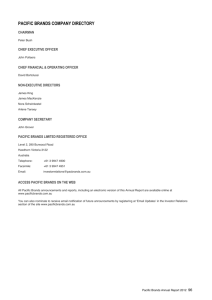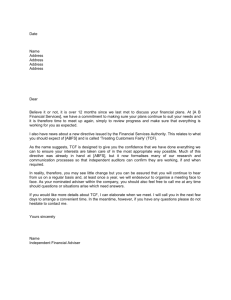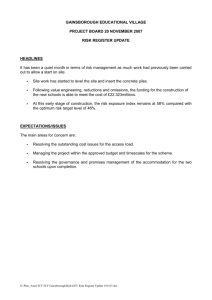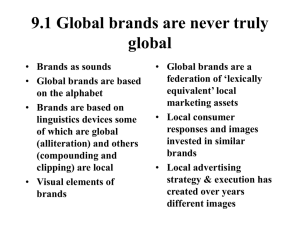PACIFIC BRANDS SUBMISSION TO PRODUCTIVITY COMMISSION
advertisement
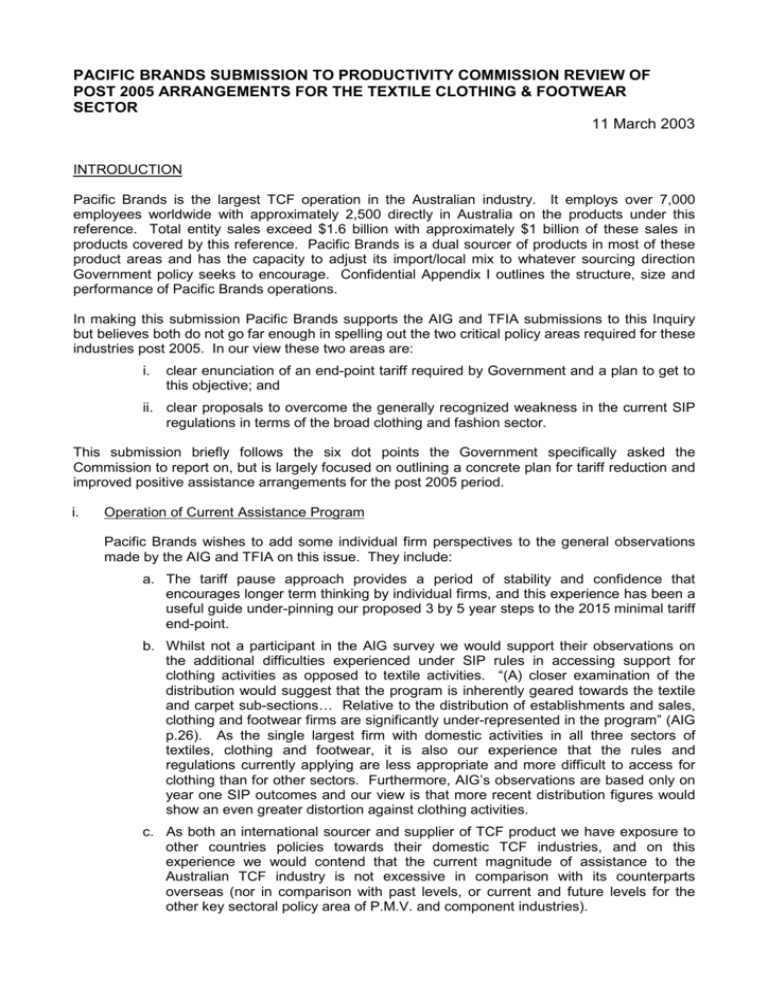
PACIFIC BRANDS SUBMISSION TO PRODUCTIVITY COMMISSION REVIEW OF POST 2005 ARRANGEMENTS FOR THE TEXTILE CLOTHING & FOOTWEAR SECTOR 11 March 2003 INTRODUCTION Pacific Brands is the largest TCF operation in the Australian industry. It employs over 7,000 employees worldwide with approximately 2,500 directly in Australia on the products under this reference. Total entity sales exceed $1.6 billion with approximately $1 billion of these sales in products covered by this reference. Pacific Brands is a dual sourcer of products in most of these product areas and has the capacity to adjust its import/local mix to whatever sourcing direction Government policy seeks to encourage. Confidential Appendix I outlines the structure, size and performance of Pacific Brands operations. In making this submission Pacific Brands supports the AIG and TFIA submissions to this Inquiry but believes both do not go far enough in spelling out the two critical policy areas required for these industries post 2005. In our view these two areas are: i. clear enunciation of an end-point tariff required by Government and a plan to get to this objective; and ii. clear proposals to overcome the generally recognized weakness in the current SIP regulations in terms of the broad clothing and fashion sector. This submission briefly follows the six dot points the Government specifically asked the Commission to report on, but is largely focused on outlining a concrete plan for tariff reduction and improved positive assistance arrangements for the post 2005 period. i. Operation of Current Assistance Program Pacific Brands wishes to add some individual firm perspectives to the general observations made by the AIG and TFIA on this issue. They include: a. The tariff pause approach provides a period of stability and confidence that encourages longer term thinking by individual firms, and this experience has been a useful guide under-pinning our proposed 3 by 5 year steps to the 2015 minimal tariff end-point. b. Whilst not a participant in the AIG survey we would support their observations on the additional difficulties experienced under SIP rules in accessing support for clothing activities as opposed to textile activities. “(A) closer examination of the distribution would suggest that the program is inherently geared towards the textile and carpet sub-sections… Relative to the distribution of establishments and sales, clothing and footwear firms are significantly under-represented in the program” (AIG p.26). As the single largest firm with domestic activities in all three sectors of textiles, clothing and footwear, it is also our experience that the rules and regulations currently applying are less appropriate and more difficult to access for clothing than for other sectors. Furthermore, AIG’s observations are based only on year one SIP outcomes and our view is that more recent distribution figures would show an even greater distortion against clothing activities. c. As both an international sourcer and supplier of TCF product we have exposure to other countries policies towards their domestic TCF industries, and on this experience we would contend that the current magnitude of assistance to the Australian TCF industry is not excessive in comparison with its counterparts overseas (nor in comparison with past levels, or current and future levels for the other key sectoral policy area of P.M.V. and component industries). d. The operation of EOAP arrangements were of considerable importance in the mid to late 90’s when end-product tariff levels were of a higher order. Pacific Brands was the initiator and principal user of the OAP arrangements for virtually all of this period. Under new tariff arrangements we now see this policy dimension to be of limited strategic relevance to our operations especially in view of the long supply lines involved and the increasing retailer pressure for short lead times.. e. The original rationalization and restructuring objectives within SIP have been lost in the wording and application of the Type 4 & 5 regulations. Again the distribution of funding to these areas over the last two years indicates how poorly this opportunity is currently being addressed, and rationalization should be generally encouraged, not just in regional areas. Pacific Brands strongly supports the strengthening of local operations by industry rationalization and the associated achievement of synergies and scale, and would strongly support the earliest possible rewording of the current provisions to enable the transfer of SIP funds into this desirable objective. ii. Major Impediments to Long-term Viability The sources of cost disabilities for these industries in Australia and other high wage cost economies have been well documented. Pacific Brands wishes to make only limited additional commend as it relates to recent experience. a. Excess world capacity in these products continues to apply and as long as the two key markets of US and Europe are effectively controlled by volume restraints this poses a major impediment to the long-term viability to the few other markets that remain open to these excess volumes. b. Recent improvements in the Australian dollar (over 25% in last 12 – 18 months) increase pressure on Australia’s garment sourcing. c. Direct retailer imports are a major market force moving local producers to switch to cheaper imported suppliers to be able to “compete with their customers”. This is probably the largest impediment to maintaining local production in the face of customer import pressure. d. Australia’s high redundancy costs by world standards exaggerates the consequences of long-term viability decisions. In small firms this may lead to delayed adjustment followed by bankruptcy. In contrast, Pacific brands policy is to ensure payment of all legal entitlements to employees as a priority in their adjustment decisions. Redundancy payments form one of the largest costs in rationalization and structural improvements to existing operations. iii. Major Opportunities to the Sector Although Pacific Brands operates in all three sectors of textiles, clothing and footwear, the observations below on opportunities for long-term viability necessarily reflect the specific product areas we currently focus on. a. Clothing constitutes the core of the TCF sector (both in terms of its overall size and in terms of the strong dependence of textile suppliers on a healthy downstream clothing industry). A balanced scenario for overall sectoral opportunities must primarily address significant opportunities for the broad clothing sector, then niche scenarios for smaller segments of the industry. b. Because of the enormous wage disparity between Australian wage rates and those RI DOO JDUPHQW LPSRUWV LQWR $XVWUDOLD on Chinese cost sheets supplying opportunities focused on “cost-only” sourcing comparisons are closely linked to capital intensive activities. In this regard we have positioned our activities in low labour, semi-textile activities like sock and thermal knitting in our recently rationalised 300,000ft2 Holeproof Nunawading plant, and pantyhose knitting in our Kayser Coolaroo plant,. Centralized knitting and cutting in our Bonds Wentworthville plant has improved the cost structure for our regional satellite plants in Unandurra and Cessock NSW. Make –up plants such as these Bonds satellite plants (and similiarly our King Gee workwear sewing plant at Bellambie) have traditionally been very vulnerable to import competition by virtue of their labour intensive nature. However cost economies in the more capital intensive elements of their supply chain (eg rationalized cutting or warehousing arrangements) has enabled improved long term prospects for these labour intensive activities. c. Quick response is a key non-price advantage for local supply in a retail market place seeking shorter and shorter lead times. Pacific Brands has invested extensively in developing totally new solutions to forecasting future demand patterns and mapped them through in integrated local supply process and workflows. Further developments are underway to increase these opportunities to better service fast turnaround demand through local supply lines. d. One of the key determinants for long-term viability in the garment industry is “brand equity”. Pacific Brands whole “modus operandi” is based on the premise that without strong brand equity matched with new product development, major retailers have no reason to source through local suppliers and will increasingly reduce their costs through direct retailer imports. iv. Post 2005 Policy Options We have considered a wide range of policy options and scenarios post 2005 and have reached a firm position on what we believe will work best to meet both Government and Industry objectives for the post 2005 period. As noted previously we don’t believe either the AIG or TFIA submission has gone far enough in this assessment and have tried to address the specific policy requirements we see as critical to delivering the Government and Industry’s objectives. In essence, we have opted to have a clear end-game consistent with the Government’s minimal tariff outcome, delivered with a significantly improved and broadened SIP program that will maintain a positive environment for industry change leading up to this minimal assistance position. In our opinion it is fair and reasonable for our employees and other stakeholders to understand what the end-point to the policy is and what positive things the Government has planned to help the long term change process and avoid unnecessary negative short-term sentiment and decision making. The proposal is for: a. 10 year program through to 2015 b. tariff cuts in 3 steps at 2005, 2010 and 2015 such that garment end products move from their current 25% to 17.5% in 2005, 14% in 2010 and 10% in 2015 (all other TCF tariff levels move in similar staged 5 year steps or until they reach 5%). c. SIP style positive assistance program to continue to be funded at no less than current levels, and to continue over this adjustment period to 2015, with the Scheme’s operation to be amended to better reflect industry adjustment opportunities, and administration flaws referred to earlier in this submission. Changes in administration to include: 1. de-linking of the type 3 value-added encouragement from type 1 & 2, with a case-by-case, competitive entry, assessment of strategic business plans for applicants to qualify for access to the 5% of value added incentives; 2. review of the “non-visual” restriction on product differentiation and development for innovative fashion and garment firms; 3. incorporation of “investment in brand equity” as well as “investment in physical assets “as currently applies under type 1; 4. examination of the merits of paying the type 3 payments as import credits as per the format of P.M.V. arrangements; and 5. review of type 4 & 5 elements to revitalize this direct encouragement of industry rationalization and to broaden its application to being wider than just non-CBD improvements. v. Workplace Issues Pacific Brands does not wish to make any comment on workplace issues other than the obvious need for a general co-operative approach between unions, employers and employees to meet the challenges facing the TCF sector. Pacific Brands is committed to local manufacturing to the extent that commercial pressures allow us to continue to be competitive in the marketplace. As noted we are very optimistic for long term viability of much of our current activities (in particular the worldclass operation of our sock thermal and hosiery operations), and believe that the careful application of reasonable planned tariff steps and a positive SIP program that works for clothing ,will avoid unnecessary job losses and employee concerns associated with tariff cuts unsupported by adequate positive development incentives vi. International Trade Developments The Australian TCF sourcing environment is closely tied to the effective removal of garment quota restraints in the major world markets of US and Europe, and whether a new unrestrained market sees China penetration of these markets move from the current 25% levels to the 60-70% import access levels experienced in the open Australian garment market. Pacific Brands does not see any significant downside in the free trade agreements with similar wage cost countries like America, nor in open access for the narrow based industries of the L.D.C. countries. vii. Conclusion As initially noted ,we support the AIG and TFIA submissions but believe their proposals do not go far enough in spelling out a policy plan required for the long term viability of the Industries. This submission has focused on providing a concrete policy option based on our wide experience in all 3 sectors of the TCF industries. We believe this proposal will work to enable optimum adjustment to a more viable and sustainable industry that is able to exist at levels of assistance that are effectively minimal in 2015. Without such a framework and positive outlook we believe the post 2005 outcomes will incur significant and unnecessary dislocation of Australian TCF activities.
